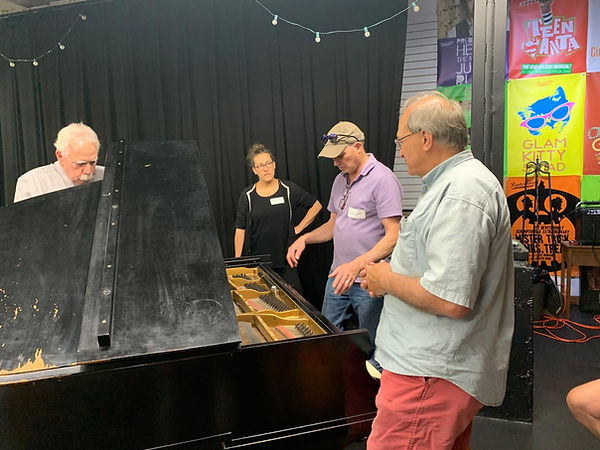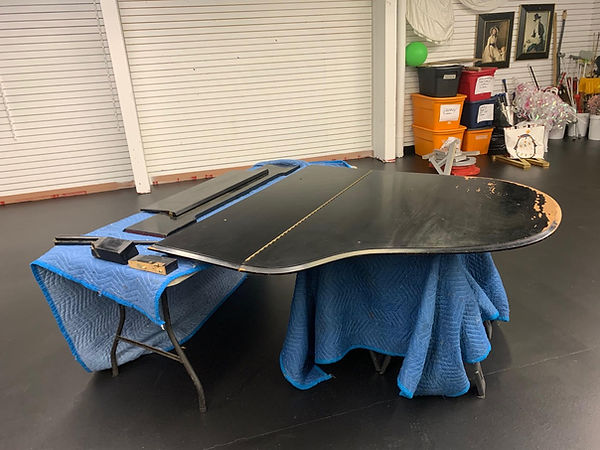Piano Technicians Guild Connecticut Chapter

The Great Nonprofit Piano Rescue Project
By Gina Bonfietti, RPT, Connecticut Chapter
This article appeared in the June 2023 issue of the Piano Technicians Journal.
(See pictures of the project following the main text of the article.)
The Piano Rescue Project was created to serve multiple purposes: generate publicity for the Piano Technicians Guild, have a fun, all-day learning project for the Connecticut Chapter, invite non-members to see what the PTG is about, and work with a local nonprofit to improve its piano. The idea was that our chapter would donate our time to “rescue” a piano and get it back into working order.
This project benefited both organizations. The nonprofit received professional services free of charge, and the chapter had a meeting place and a piano to train members with. It was a feel-good story that the local radio station and newspaper were happy to pick up. There was a ten-minute radio interview with over one million listeners and a front-page newspaper story for this event. We contacted a TV news station that was interested but didn’t have a crew available to cover the story that day. The publicity allowed us to promote the Connecticut Chapter, RPTs, the PTG, and the nonprofit.
We had some qualifications we looked for in an organization to work with:
-
The benefit organization had to be a nonprofit.
-
They had to use a PTG member as their technician.
-
They had to be willing and available to talk to the media.
-
The organization had to be open to all and benefit everyone in the community.
-
The location of the piano had to have enough workspace for a large group to spread out and work.
We chose a local theater company, Pantochino Productions Inc., which produces musicals for adult actors, teens, and elementary-age children. I have serviced Pantochino’s pianos for years. So, when a local piano teacher wanted to donate his beloved Baldwin, I thought the theater company would be a good fit, even though the piano needed work.
The piano in question was a Baldwin M from 1968 with some significant issues. The case finish was falling off, some notes didn’t work due to unglued wippens, the hammer heads were clicking, and the ribs were unglued. The regulation needed some touching up, and there was 50 years of dust to contend with. There was plenty of work for everyone in the chapter.
We gathered at 10:00 a.m. on June 15th, 2022. In attendance were members Greg Cole, Rich Lindahl, Noelle Chave, Doug Mahard, Josie Lane, and Jim Salvatore. RPTs included Gina Bonfietti, Evan Dunnell, Amy Tiernan, Jim Tiernan, and Ken Farrington; guests were Bryce Farrington, Brian Stocklin, and Todd (no last name given).
I had evaluated the piano beforehand and knew what the major concerns were: The case needed work, the piano needed to be cleaned, and some notes didn’t work. The plan was for each member of the team to assess the condition of the piano individually and come up with what they would do to the piano. Once everyone had a chance to inspect the piano, we discussed our plan. There would be four stations: case finish repair, cleaning, and two action stations. One of our members is a refinisher and offered to work on the case; another technician refined his cleaning technique and offered to start the cleaning. We all moved around and filled in as needed.
In three and a half hours, the case was repaired, the inside was cleaned, the nonworking parts were repaired, the hammers were reshaped, the action received a quick regulation, the ribs were glued, and the piano was tuned. We worked together, and members shared their ideas about how they would fix an issue. We had rebuilders, field technicians, an action specialist, a refinisher, and a handful of new technicians.
Here are some quotes from two newer members of the CT Chapter:
Greg Cole said, “I jumped at the opportunity to work on the piano’s worn-out cabinet and joined a couple of my new friends to learn how to clean up and repair damaged finishes that I see all the time when I tune. I was surprised to find out that by applying simple techniques, a lot can be accomplished with the use of easy-to-find tools and products that can make a huge difference. The best thing was that after we packed up our toolkits and went home, I realized I no longer felt I was the new kid on the block. These are my peeps!”
Noelle Chave said, “The all-day Piano Rescue Project was an all-around rewarding experience. Not only was I able to contribute in part to giving back to the community, but I got to watch and learn from some of the top techs in our state. We discussed what to look for when assessing a piano, I was shown various techniques for completing certain tasks, and I learned a lot about what works to prioritize tasks, given the quality of the instrument and the time we had to work on it. I hope there will be more to attend in the future!”
Beginning Condition

Piano yoga or accessing the loose ribs? Jim Salvatore, Josi Davis, Doug Mahard, and Noelle Chave. The case finish was worn and missing paint, and was a major concern for the theater company as the piano is located in a busy area with many visitors.

The soundboard and ribs were inspected; we found that a wine cork had been crammed between the ribs to dampen vibrations from separation from the soundboard.

The damper tray pin had worked its way out, causing an irregular motion in the pedal movement.

A dirty pin field.

More dirt on the soundboard.
Assessing the Piano

From left to right: a guest and chapter members Josi Davis, Doug Mahard, and Jim Salvatore.

Various tool kits of our members

Guests Bryce andTodd cleaning the soundboard,plate,and dampers. Action Repairs: Jim Salvatore, Doug Mahard, guest Brian, AmyTiernan, and Evan Dunnell. Parts Selection: Jim Tiernan and Noelle Chave.

Rich Lindahl, refinisher, was in charge of the case. The stack was removed from the keys, the unglued parts were glued, and the hammers were reshaped. With the lid removed, the soundboard, dampers, and plate got a deep cleaning.

JimTiernan watches as Ken Farrington adjusts the glide bolts. Evan Dunnell explains the process to Noelle Chave. Ken Farrington uses the Davis white key leveling device as a quick way to set the glide bolts. (Adjust the device so that when it’s positioned on the key next to the glide bolt, the brass button is level with the top of the tool. Then adjust the glide bolt to where you just start to see the button rise.)

Case work: Lots of touch up work was needed. The piano had been located next to the windows of a very old house, where it was subjected to leaking windows and bright sun. Noelle Chave does the fine touchup with a paint brush and lacquer paint.

The lid condition before refinish work was started.

Some of the refinishing supplies.

Josi Davis, Greg Cole, Rich Lindahl, and Doug Mahard refinishing the fallboard.

The lid refinishing in process.

Music desk after finish touch up.

Reshaping hammers.

Rib repair: Original Gorilla Glue® was used to fill the void between the ribs and the soundboard; no clamps were needed.

Cleaning: Amy Tiernan getting between the strings, while Doug Mahard assists with the vacuum and Bryce Farrington supervises. The cleaning crew used water, dish soap and a dab of ammonia to cut through the gunk. (If it’s a bit dirtier, you can use a little more ammonia but test a spot first.) Other equipment included plenty of rags, a stiff, big paint brush to use in the tuning pin area, soundboard steel, Polita string cleaner, and Spurlock sweepers.

A clean piano.

Doug Mahard tuning with a Bose® noise cancelling headset as Noelle Chave and Josi Lane continue the case touch-up at the same time.


The final product: Finish repair, cleaning, mini action regulation, tuning, and rib repair all done in three and a half hours.
The chapter had a great time, everyone learned something, and the nonprofit was very happy. The amount of work that was done was amazing. The bonus was that we all learned something from this event, from the beginner to the 40-year RPT.
Pantochino Productions had this to say about the project: “This was a gift! The amazing work of the PTG was like getting a brand-new instrument. We’re forever grateful to them for choosing our piano to restore and will make use of it in our rehearsals for many years to come.”
Gina Bonfietti, RPT, has been a proud member of the Connecticut Chapter for over 30 years and is currently the Northeast Regional Vice President. Gina has been a full-time technician since 1990. She has taught classes for chapters, regionals, and the annual convention.